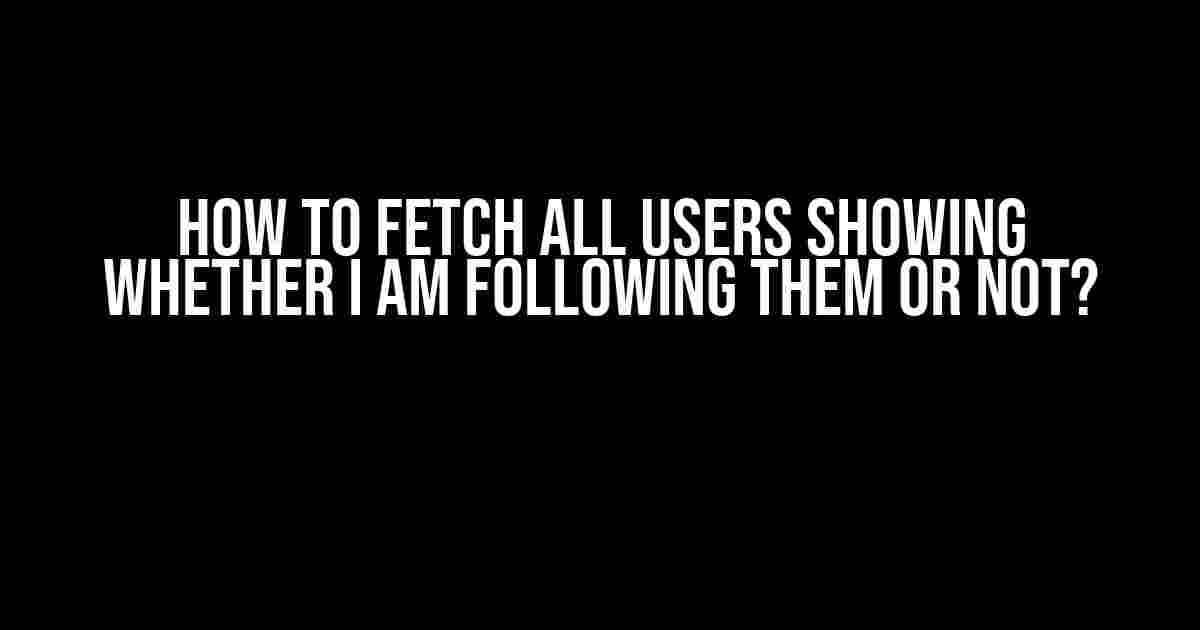Welcome to this comprehensive guide on how to fetch all users, displaying whether you’re following them or not! This tutorial is designed to help you navigate the process with ease, providing clear instructions and explanations to get you started.
Understanding the Basics
Before we dive into the nitty-gritty, let’s understand the requirements and assumptions for this task.
You’ll need to have a basic understanding of:
- API calls and responses
- JSON data processing
- Programming languages (we’ll use JavaScript for this example)
Assumptions:
- You have an existing user account with the necessary permissions to fetch user data.
- You have access to the API documentation and the necessary API keys or tokens.
Gathering User Data
To fetch all users, we’ll need to make an API call to retrieve the user list. The exact endpoint and parameters will vary depending on the platform or service you’re using.
Let’s assume we’re using a fictional social media platform, “SocialHub,” with an API endpoint to fetch all users:
GET https://api.socialhub.com/v1/usersThe response will typically contain an array of user objects, each containing essential information like user IDs, usernames, and profiles.
[
{
"id": 1,
"username": "johnDoe",
"profile": {
"name": "John Doe",
"bio": "Software engineer and coffee enthusiast"
}
},
{
"id": 2,
"username": "janeSmith",
"profile": {
"name": "Jane Smith",
"bio": "Marketing guru and travel lover"
}
},
...
]Determining Follow Status
Now that we have the user list, we need to determine whether we’re following each user or not. This typically involves making another API call to fetch the follow status for each user.
Let’s assume the SocialHub API provides an endpoint to fetch the follow status:
GET https://api.socialhub.com/v1/users/:userId/followingThe response will indicate whether we’re following the user or not:
{
"following": true
}or
{
"following": false
}Implementation in JavaScript
Let’s create a JavaScript function to fetch all users and determine whether we’re following them or not:
async function fetchUsersAndFollowStatus() {
try {
// Fetch user list
const response = await fetch('https://api.socialhub.com/v1/users');
const users = await response.json();
// Fetch follow status for each user
const usersWithFollowStatus = await Promise.all(users.map(async (user) => {
const followResponse = await fetch(`https://api.socialhub.com/v1/users/${user.id}/following`);
const followStatus = await followResponse.json();
return { ...user, following: followStatus.following };
}));
console.log(usersWithFollowStatus);
} catch (error) {
console.error(error);
}
}
fetchUsersAndFollowStatus();Example Output
The function will log an array of user objects, each containing the follow status:
[
{
"id": 1,
"username": "johnDoe",
"profile": {
"name": "John Doe",
"bio": "Software engineer and coffee enthusiast"
},
"following": true
},
{
"id": 2,
"username": "janeSmith",
"profile": {
"name": "Jane Smith",
"bio": "Marketing guru and travel lover"
},
"following": false
},
...
]Table of Results
Let’s display the results in a neat table:
| User ID | Username | Profile | Following |
|---|---|---|---|
| 1 | johnDoe | John Doe (Software engineer and coffee enthusiast) | Yes |
| 2 | janeSmith | Jane Smith (Marketing guru and travel lover) | No |
Conclusion
In this comprehensive guide, we’ve covered the steps to fetch all users, determine whether we’re following them or not, and display the results in a neat table.
Remember to adapt the code to your specific use case, and don’t hesitate to reach out if you have any questions or need further assistance.
Happy coding!
Frequently Asked Question
Are you tired of scrolling through your social media feed wondering who you’re following and who you’re not? Well, we’ve got you covered! Here are some frequently asked questions about how to fetch all users showing whether you’re following them or not.
How can I get a list of all users and their follow status?
You can use the social media platform’s API to fetch a list of all users, and then use the “Get Following” endpoint to check if you’re following each user. This will give you a list of users with their corresponding follow status.
What if I want to fetch all users, including those I’m not following?
In that case, you’ll need to use a combination of the “Get All Users” endpoint and the “Get Following” endpoint. First, fetch all users using the “Get All Users” endpoint, and then use the “Get Following” endpoint to check if you’re following each user. This will give you a complete list of all users, with their follow status.
How do I handle pagination when fetching all users?
Most social media platforms use pagination to limit the number of results returned per API call. To fetch all users, you’ll need to use pagination to fetch users in batches, and then combine the results. Be sure to check the API documentation for the specific platform you’re using to learn how to handle pagination correctly.
What if I want to fetch users from a specific group or community?
If you want to fetch users from a specific group or community, you’ll need to use the “Get Group Members” or “Get Community Members” endpoint, depending on the platform. This will give you a list of users who are part of the group or community, and you can then use the “Get Following” endpoint to check if you’re following each user.
Can I use a third-party library or SDK to fetch all users and their follow status?
Yes, many social media platforms provide third-party libraries or SDKs that can help you fetch all users and their follow status. These libraries often provide a simpler and more convenient way to interact with the platform’s API, and can save you time and effort. Be sure to check the platform’s documentation to see if they offer a library or SDK that meets your needs.
